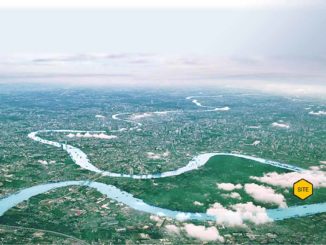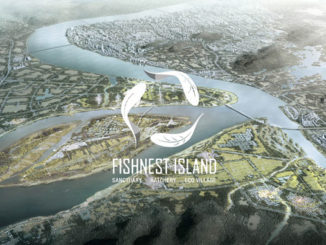Transforming the urban landscape competition – creating a vision for post-COVID-19 streets and spaces. Landscape Institute’s latest international design competition reveals future shape of the high street.
COVID-19 has had a devastating and unprecedented effect on people’s lives, their lifestyles and the places where they live. The ideas entered into the competition provide us with a wealth of new thinking about the future design and management of the public realm.
The competition, which was supported by GreenBlue Urban, Ground Control, Hardscape, Selux and Vestre, attracted 160 student and professional entries from China, Thailand, Israel, Turkey, Denmark, Spain and the UK.
Jane Findlay, President of the Landscape Institute, commented, ‘The competition was designed to generate new thinking and to offer a platform for entrants to engage with the debate about the future of our public spaces. I was delighted to see such imaginative and hopeful thinking.’
‘The quality of the submissions was incredible, not only in the standard of presentation but also the quality of thought and creativity. There is a great deal of talent out there. It is exciting to see that that the quality of the design of our urban spaces is in safe hands if we give our designers the opportunity to truly exercise their skills.’
Jane Findlay made the announcement today at the Landscape Institute end-of-year webinar with competition partners Romy Rawlings, Vestre; Norman Emery, Selux Lighting; Warren Heaton, Ground Control; Mathew Haslam, Hardscape; Howard Gray, GreenBlue Urban; and other competition judges Dr Nelson Ogunshakin and Dr Krystallia Kamvasinou.
Professional category winner:
Back Down To Earth
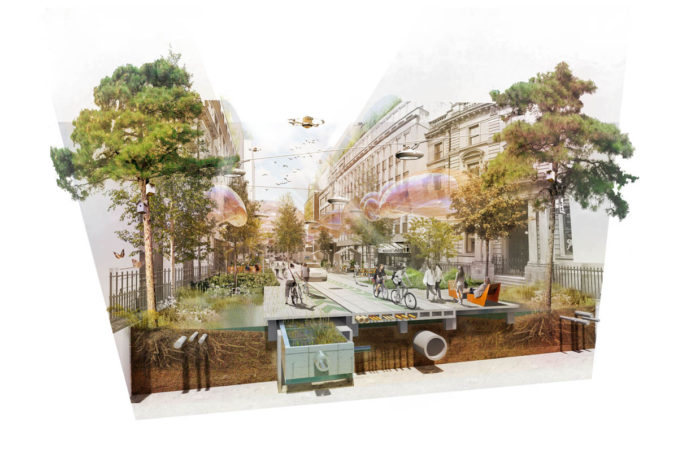
A joint collaboration between landscape architect, graphic designer and artist Hilary Barber and Adam Greatrix, the associate partner from the Gillespies Leeds studio. The proposal is based around the street where they work – South Parade, Leeds.
The winners have set a new standard for high streets to tackle climate emergency and COVID-19. They said in their entry: “This is the street where we work, an unremarkable street, full of tarmac and cars. It is exactly this type of street where an environmental revolution could take root – responding to the post COVID-19 opportunities and importantly, the climate emergency, to radically rethink our urban streets, for the sake of humanity.”
Professional category runners up:
Canal Park Erewash – A Park for Vitality
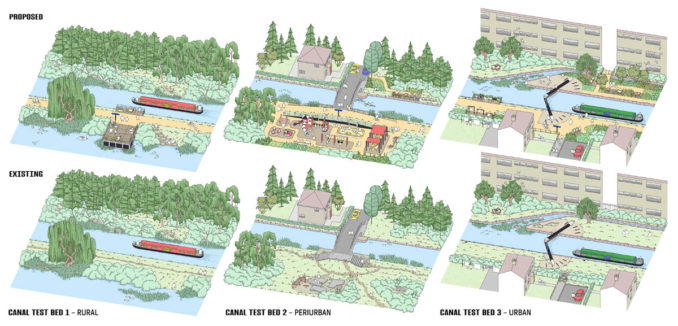
By Joe Bossley, Senior Landscape Architect at FIRA. Since the start of the pandemic, the canal corridor has become a vital escape for people needing to mentally and physically recharge. This increase in pressure on already constrained sites has exposed the challenges for visitors who wish to enjoy the canal whilst staying safe. The proposal is to transform the Erewash Canal into a parkland destination that works for all.
My Third Place
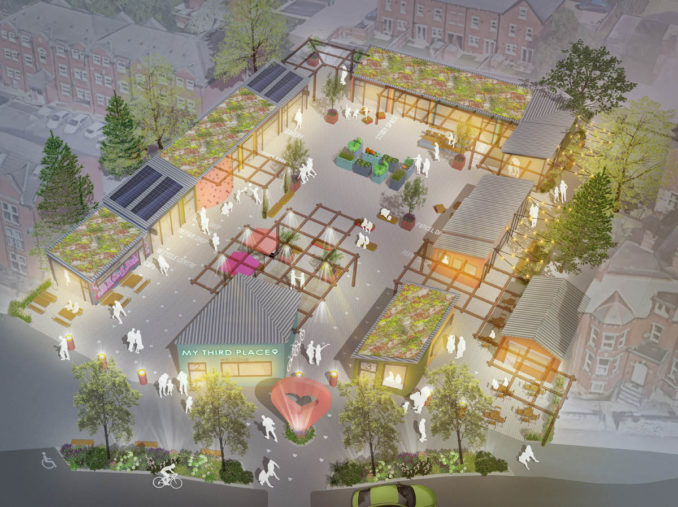
By Simon Hall, Director and Landscape Architect at PWP Design Limited in collaboration with R Vint Engineering. My Third Place is somewhere to connect with the local community, engage in cultural events and socialise with people outside of home and the workplace. It is based around showing how there are opportunities within every community and how the profession can bring these underused spaces back to life using Hyde Park, Leeds as an example.
Student category winner:
Link Area – Flowing Connection After the Pandemic by Zhouhui Lu, student at the University of Sheffield, who chose an abandoned space in the centre of an area in his hometown in Beijing. It was designed as an open urban green space that could gradually transition from artificial to a natural environment by creating new habitats.
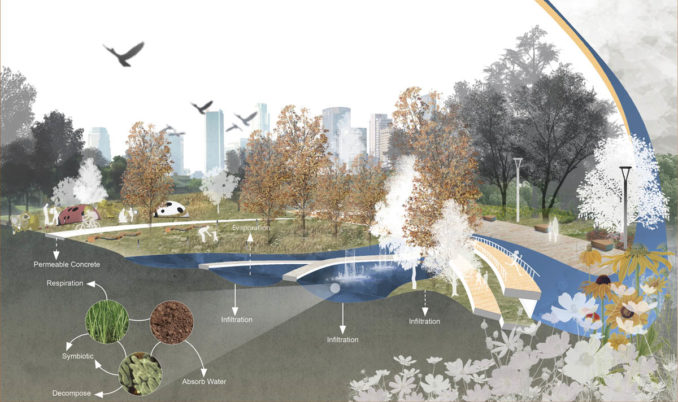
Student runners up:
Nature Works – Redefining Urban Workspaces as a Framework for Well-Being in Everyday Life by Shahaf Zakay, a student at Israel Institute of Technology who describes a project for industrial sites along river banks in Tel Aviv, Israel, aspiring to create balance and harmony between nature and man, enabling normal life patterns to exist. It aims to provide enhanced biophilic surroundings, as an inherent part of everyday routines.
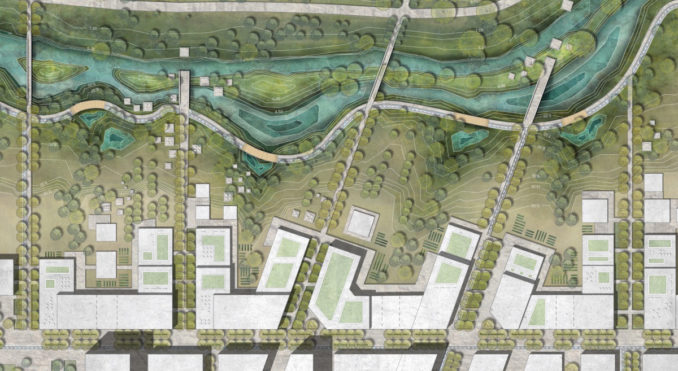
Warm Youth – by the student team at Beijing Forestry University: Binming Huang: Main planner; Sida Zhang: Designer and draftsman; Lian Liu: Designer and graphic designer; Zitong Feng: Designer and draftsman; and Yuan Ma: Designer and draftsman.
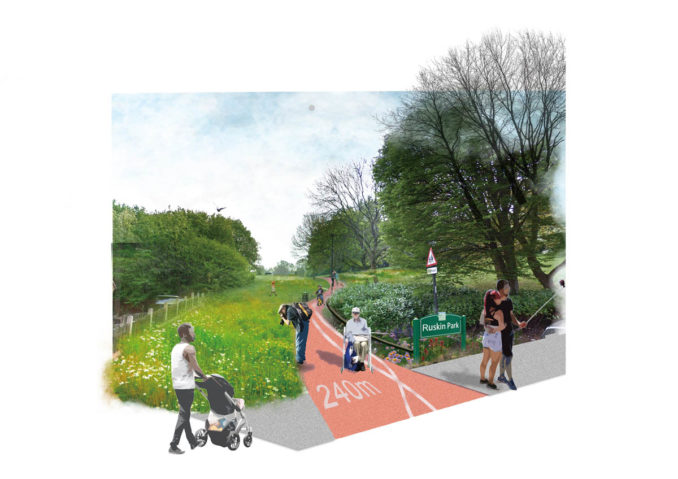
This entry highlights the situation faced by a high-density community (the Huitian District, Beijing) which has brought huge challenges to epidemic prevention. It proposes to use intelligent and green spaces to make closer connections for different groups and improve people’s mental health.
Andrew Cottage, who managed the Transforming the urban landscape competition for the Landscape Institute, said, ‘An overall message is that people are passionate about the quality of the places where they live and they want to have a voice and more control over those places. The message to developers and decision-makers is clear – allow people the opportunity to have a say in the places where they live and we can create places that will both address the climate emergency and provide spaces that will be suitable for communities in post-COVID times.’
A number of entries indicated concern about mental health, health and wellbeing and community. Entry names such ‘let health care be more than in hospital’; ‘landscape safety net’; ‘cities need to breathe’; ‘no car parks’, ‘nature-based solutions to climate change’; and ‘adapt landscape planning for city centres’ indicate the range of concerns.
Judge Dr Ally Lu, Department of Urban Studies and Planning at the University of Sheffield, said, “The competition has successfully drawn entries from a wide international perspective. I’m particularly interested in student submissions that reflect on their own cultural context and heritage landscape. The project The Narration of the Crack adds a layer of collective memory arising from the pandemic and an earthquake into the design. The notion of remembering and transforming adversity into a positive future is encouraging. This was also present in entries which addressed the public space of Hutong in China, Yards in Greece and Ipoh Old Town in Malaysia. This is a good reminder that we can learn from the past and unlock the potential of our urban historic landscape in building post-pandemic sustainability.’
The Landscape Institute looks forward to promoting the entries to civic leaders around the world as we move toward a greener recovery from this pandemic. This approach also includes our work in England as part of the UK Government High Streets Taskforce.
See the Competition exhibition at https://competitions.landscapeinstitute.org/transforming-the-urban-landscape/exhibition/


